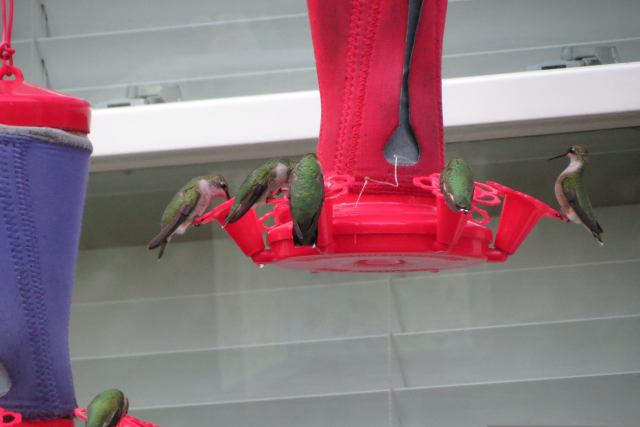Keep Feeders Up
Maintain at least one feeder for a week or two after your last sighting. "The feeders do not entice them to stay," states ornithologist Laura Erickson. The birds have an instinct to move with the maximum availability of food. If migrating birds could be easily enticed to stay for food, none of them would get anywhere because they would have the maximum food available right up until fall's first killing frost—when it would be too late for so many hummingbirds to be moving. Any stragglers are just not in condition to move when they should. They need your feeders as reliable sources of food in order to have the best chance at catching up when few natural flowers are still in bloom.
Bring Feeders Inside on Cold Nights
Add a sleeve, as shown in the photo, or simply bring feeders inside at night. Put them outside in the early morning so hummers don't drink dangerously cold liquid. Here's why: Hummingbirds can lower their body temperature overnight to conserve energy but the trickiest part of that adaptation, called torpor, is getting the body temperature back up in the morning. A hummingbird must warm up its body the moment it awakes. It shivers to warm up, but the tiny bird's stomach is empty and shivering uses up stored energy. During this warm-up time, the bird is sluggish, groggy, and very hungry. As soon as it can, it flies off to eat breakfast. Some people have observed hummers suffering hypothermia when perched to drink very chilled water. Experts do not offer an arbitrary temperature at which this may happen as there are no studies to support this, according to Shari Williamson, one of the world authorities on hummingbirds. It is safe to say that warm food helps warm up cold birds.
Adjust Sweetness for Conditions
Hummingbirds thrive on sugar water that matches, roughly, the sweetness level of natural nectar, which is from about 1:5 to 1:3. Ornithologist Laura Erickson personally recommends using 1:4 during normal conditions, 1:3 when it's cold and wet, and 1:5 when it's hot and dry (to help protect the birds from dehydration). Many birders advocate for 1:2 or 1:1 as "high octane fuel" to replenish a hummer's energy reserves during migration, but until there's more robust information to prove that too much sugar without enough water won't cause problems for hummers, it's best to err on the side of caution. From decades of studies, we know that 1:5 to 1:3 are healthy levels to use in making sugar water for hummingbirds.
Keep Feeders Fresh
Nectar in your feeders must be changed to keep it fresh so it doesn't ferment and end up with mold growing in it. Change solution immediately if it gets cloudy or you see mold. Change it at least every four or five days, and much more often during temperatures above 90F (32.2C). Any syrup solution will spoil eventually, regardless of temperature, so keep a careful eye on it.
Have the Right Feeder Size and Type
Choose a feeder you are willing and able to clean with each change of food. Choose one that fits the size of the hummingbird population that visits your feeders. More feeders will support more hummingbirds, and will help reduce territoriality. Fill a feeder only partly full if the food is not being used.
Hang in There!
"Hanging a hummingbird feeder means assuming a certain amount of responsibility for the well-being of a fragile and trusting animal," reminds Lanny Chambers, JN's hummingbird expert. The energy a hummer stores by the end of a day usually is just sufficient to survive overnight. Their survival depends on eating frequently or they continually face the danger of starving. |

David Roth

Treesa Morris
|




